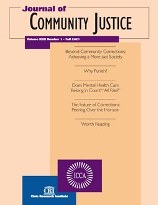Complete Issue
Author: Donald G. Evans.
Source: Volume 27, Number 03, Spring 2018 , pp.1-32(32)

< previous article |return to table of contents
Abstract:
This issue is highlighted by four informative and interesting articles that describe a day reporting center, an emerging issue relating to trauma and refugees, a case study of how one agency dealt with siting issues, and an approach to staff training in dealing with mental illness. Day Reporting Programs: Current efforts to reduce the size of prison populations have led to the search for non-residential alternatives, and among the alternatives currently being used is the day reporting center. The research regarding outcomes for day reporting centers has not been as promising as expected and has led to an increase in studies by agencies contracted to operate them. Alex Dorman, Derek Ault, and Alex Boros, from Oriana House Inc., in Ohio, used staff and participant interviews to study the barriers to success in three day reporting centers in different geographical locations in the state. They found that a major barrier to success related to access to transportation, either because the participants could not afford bus fare or did not have a driver’s license. Trauma: The Not So Silent Undercurrent for Refugees in Community Corrections Programs: Immigration and refugee policies are hot-button topics in most Western democracies, and community-based agencies need to be aware of the fact that these populations differ in terms of voluntary decisions to leave the home country and the current involuntary displacement that has been caused by war, the actions of harsh regimes, and the results of climate change. In an article sponsored by the Healthy Minds Group, Jim Struve and Joanna Colrain provide community corrections practitioners with an educational article regarding the importance of addressing trauma within the context of the controversy about immigration and refugee policies and practices. Staying the Course: Perseverance in the Face of Siting Litigation: Since the very commencement of using “halfway houses” and community residential services for individuals released from prison on supervision, the issue of community support for siting these “homes” has been problematic. The siting battles have diverted monies and staff time that could have been used to assist individuals to reenter the community safely and productively. Kevin Downey has written an informative case study of the struggle through which his agency, Crosspoint, Inc., persevered in serious litigation concerning its efforts to open a facility in San Antonio, Texas. It would be useful for other residential providers who have, or have had, similar struggles with siting to consider a submission to JCC about their experiences. The Importance of Staff Training in Mental Health: The number of offenders in prison and in community programs who have mental health problems is increasing. In community-based programs, the proportion of clients who are assessed as high risk/high need has also increased, and a number of these clients have mental health problems, addiction issues, or both. Dr. Randy Shively, from Alvis, in Columbus, Ohio, reminds us of the importance of staff training regarding mental health issues. He highlights the problem of staff turnover at entry-level jobs and stresses that even in agency orientations, there should be exposure to the basic signs and symptoms of mental illness.Keywords: day reporting, community corrections, substance use treatment, barriers, transportation; refugees, trauma-informed services; reentry program, transitional facility, community resistance, siting a facility, zoning; mental health, correctional staff tr
Affiliations:
1: Editor.